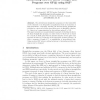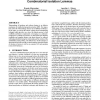610 search results - page 26 / 122 » Using SAT in QBF |
CP
2009
Springer
13 years 5 months ago
2009
Springer
Abstract. Lazy clause generation is a powerful hybrid approach to combinatorial optimization that combines features from SAT solving and finite domain (FD) propagation. In lazy cla...
AIPS
2008
13 years 10 months ago
2008
In this paper, we report on a new solver for large instances of the Disjunctive Temporal Problem (DTP). Our solver is based primarily on the idea of employing "compact" ...
SAT
2010
Springer
13 years 11 months ago
2010
Springer
Non-trivial linear straight-line programs over the Galois field of two elements occur frequently in applications such as encryption or high-performance computing. Finding the shor...
GECCO
2008
Springer
13 years 8 months ago
2008
Springer
Hill-climbing has been shown to be more effective than exhaustive search in solving satisfiability problems.Also, it has been used either by itself or in combination with other ...
DAC
2001
ACM
14 years 8 months ago
2001
ACM
Watermarking of hardware and software designs is an effective mechanism for intellectual property protection (IPP). Two important criteria for watermarking schemes are credibility...


